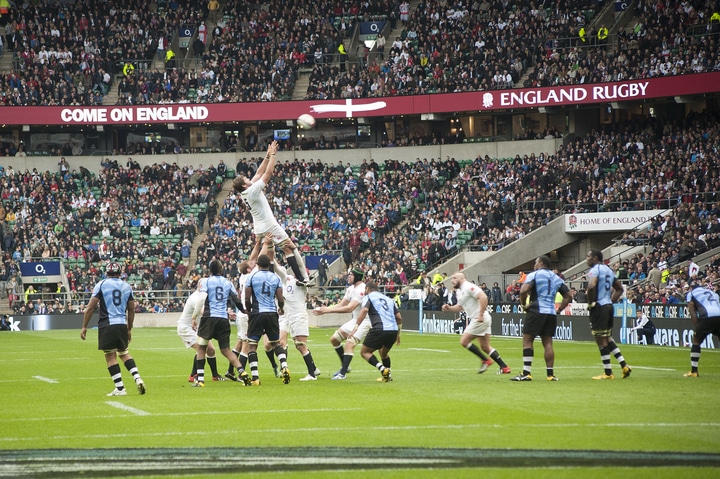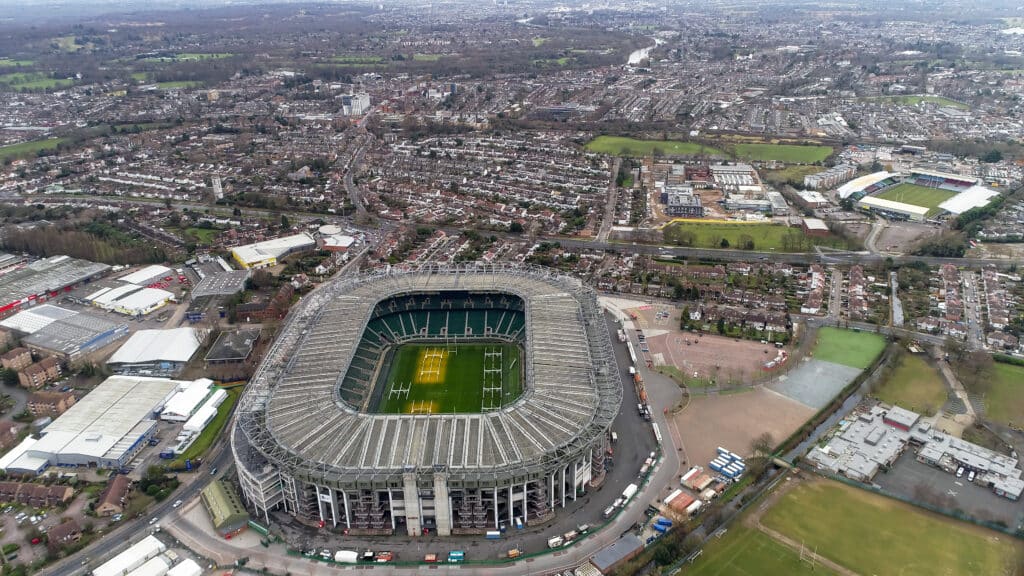Among the many pearls of wisdom emerging from the application of continuous improvement FM principles is that this concept is never finished, which is shown in perfect clarity in the running of the Rugby Football Union (RFU) Twickenham Stadium.
Head of venue facilities David Hewins recently welcomed FM Director to the site to explain the many developments undertaken during his five-year tenure and those planned for the year ahead. Similar to the majority of sporting venues around the UK, the stadium experienced considerable disruption to its schedule during the coronavirus pandemic but is now fully open again.
In addition to the return of the schedule for international rugby matches and full spectator attendance, the venue also includes facilities such as a hotel, gym, restaurants, the World Rugby Museum and a number of adaptable event spaces. It is the largest dedicated ruby union venue in the world and its 115-year history has seen it survive two world wars, numerous political changes and, most recently, the COVID-19 pandemic, along with the various challenges emerging from worldwide events.
Mr Hewins and his team have guided the stadium through one of its most difficult periods in dealing with the closure and reopening of the facility. Several projects were initiated and completed over the last three years, taking advantage of this closure, and with others following as part of the drive to deliver improvements in all areas.
“One of our latest projects has been the installation of more polycarbonate roof panels for the stadium,” says Mr Hewins. “We’ve now replaced three quarters of all roofing panels and that’s saved a fair amount of energy as we don’t need as much lighting now.”
The stadium has also benefited from the installation of new speakers and improvements to wheelchair access for disabled spectators, which has coincided with upgrades and improvements to changing rooms and washrooms. “You’d think it would be relatively easy in a stadium of this size to upgrade disabled toilets, but that wasn’t the case,” Mr Hewins continues.
“It’s actually quite a challenge to find more space to fit everything in without having to commit to redeveloping entire areas. We’ve replaced the storm drains in the stadium as part of our drive to improve health and safety, with one of the benefits being that wheelchair users will have a smoother ride as they access the improved disabled bays around the pitch.
“We’ve also set up a dedicated supply team to provide better access for those that need support and we’re also now looking at creating sensory rooms and better use of colour around the stadium for those with visual impairments.”
One of the most successful outcomes has been the focus on reducing energy, which was already delivering significant benefits before this year’s utility price increases. Much of this has stemmed from the RFU partnership with CBRE Global Workplace Solutions (GWS) and is a result of considerable efforts to map and detail all the stadium’s assets and systems from 2016 onward.

Being armed with an accurate picture of the stadium’s systems and requirements allowed a concentrated focus on optimising these without impacting the quality of the visitor experience. One of the results showed lighting as a major consumer of electricity during match days, with the majority of lights switched on throughout the day.
After adjusting these settings to provide full lighting around match times and reduced levels before and after the games, the stadium has seen significant reductions in its electricity consumption, further assisted by the installation of polycarbonate roof panels. Additional savings have also been achieved in its gas usage through the optimisation of systems and more projects are ongoing and being considered.
Sodium lighting is used by the grounds maintenance team to maintain the quality of the pitch throughout the winter months. The system has recently been upgraded and now uses more powerful luminaires which, although more expensive to operate than the previous versions, have resulted in shorter running times and cost less overall.
Mr Hewins explains that the head groundsman has adopted a “more science-based approach” to the maintenance of the pitch and this is entirely aligned with the methods applied by the estate management team. The drive to reduce energy is ongoing and one of the main areas of concentration.
“We have two main lines of focus, one of which is our new analytics system that will help us to identify any areas to reduce wasting energy. This shows everything in great detail, even down to individual valves,” Mr Hewins continues.
“In addition to installing more LED lighting, the installation of improved efficiency burners will provide more reductions in energy usage and we’re continuing to look at the behaviours of stadium staff and visitors. We’ve seen that encouraging people to be aware of their energy usage and to switch things off when they leave the building helps a little bit in the short term, but you then see that reduce as time progresses and you need to constantly remind everyone.
“So we’re now looking at the use of more automation, such as presence sensors that work with the BMS system to make sure everything is turned off when it’s not needed. We’re effectively attempting to remove the human factor from our energy consumption and it’s already paying off.
“We’ve reduced our non-event day energy load by 20%, which is saving a great deal of cost in the present climate of high energy prices,” he continues. “But it’s easy to waste a lot of money very quickly if you’re not managing everything.”
Although the pandemic had a significant impact, Mr Hewins states that the actions taken have allowed the team to improve its management of energy usage. “We turned everything off and that means we know our minimum energy base load and the level of risk we can take with our systems. While the stadium was shut, for example, we turned all our roof fans off that reduce condensation and only lost three small fans when the system was turned on again.”
Water pumps were also used less and flushing operations were reduced after the estates management team dosed the distribution system during lockdown, resulting in more savings of energy and water. “We took risks while the stadium was empty and we learned a lot about what we could do,” says Mr Hewins.

“Before COVID, we used to have the entire stadium cleaned immediately after matches, which meant having people on site late into the evening. We looked at this and now only clean the public areas after matches and use our core staff more to avoid night cleaning.
“We sometimes have tours on the days after matches, so the areas visited need to have been cleaned, but this has saved us money and resulted in better standards, so it shows how we always need to question established practices and change these where needed.”
Twickenham stadium has a capacity of 82,000 spectators that requires a major mobilisation of resources, including having all systems working at optimum levels on match days, and further benefits have arisen from the automation of tasks, Mr Hewins explains. These have been considerably reduced in number, despite the fact that spectators are spending more time on site following the introduction of additional events before and after games, depending on the time of the matches.
“During any match day, we used to have between 300 and 400 tasks to complete to keep everything switched on and working, but now it’s around 50. The rest have either been automated or they’ve been dealt with earlier and that’s another result of the pandemic and our investments in automation technology.”
In addition to the RFU award-winning partnership with CBRE GWS, Mr Hewins states: “We have a seamless relationship with all our service providers, which means we all work towards keeping the stadium fit for use. There are always frustrations, of course, but we deal with these and take everything we learn into the next project to provide continually improving outcomes.
“We share the details of our budgets with our service partners, so everyone knows where we are and what’s needed,” he continues. “It’s a very open process and we make sure we protect service providers’ payments, then use the rest to reduce risk, including more planned maintenance to avoid the cost and inconvenience of reactive callouts.
“This provides a better outcome for both Twickenham and its service partners and with a venue of this age and size, the budget will never be enough to solve all issues. But working collaboratively with our contractors allows us to avoid confrontation and any savings are then reinvested in the stadium to make sure that Twickenham operates at its optimum level.”
He further explains that the high level of collaboration with its service partners has helped the stadium to understand more about its carbon footprint as part of its environmental, sustainability and governance (ESG) strategy. The gaining of ever higher levels of knowledge about the facility continues to deliver benefits in all areas of its management.
“We’re managing a complex 50-acre estate so it’s essential to have a high level of understanding about everything, from our carbon footprint and energy usage to the amount of waste produced and recycling levels,” he continues. “We’re now putting this knowledge to good use before setting any targets, so these are realistic and achievable.”

The subject of knowledge and expertise is further discussed by Mr Hewins, who believes it is important for FMs and estate managers to have as much understanding as possible about the various aspects of their facilities. He has found working for a service provider earlier in his career has proved to be highly beneficial in many ways.
“I think it’s now essential to have sound technical knowledge and understanding within all areas of FM, which helps to remove many of the barriers between clients and their service providers. If you can understand what’s needed and can visualise how to get there you can help others to improve their knowledge, too,” he continues.
“It’s often a two-way process and it’s really helpful to establish a problem-solving mentality and be able to look at the wider picture when issues occur. This frequently means that you find better solutions and can often solve problems quicker.”
How this applies to the running of the Twickenham stadium can be seen in the introduction of mitigation when jobs are raised through the helpdesk. Works tasks can only be mitigated for genuine reasons, such as waiting for parts, etc, but Mr Hewins has found this to be a valuable addition that could not have been considered without the in-depth knowledge within the estates management team.
Given the open relationship with its suppliers, it is perhaps unsurprising that there are no key performance indicators (KPIs) for service providers. This is intended to prevent the issues seen in some areas of the FM industry, where missed KPIs are used by clients to demand money back from contractors.
“That’s one area the industry really needs to address and I know that without the great relationships we have with our suppliers we wouldn’t have been able to achieve all the energy savings and sustainability successes we’ve seen,” says Mr Hewins.
Future plans include establishing beehives on the roof of the stadium and in one of its car parks, with beekeeping lessons planned for staff next year. This will be combined with the planting of fruit trees within open areas that will further support the initiative and raise the stadium’s sustainability credentials.
Twickenham Stadium is continuing to receive considerable advantages from both its long-term strategies and working closely with its contracted providers to ensure that all aspects of the facility are fully supported and benefit from exemplary levels of service.







